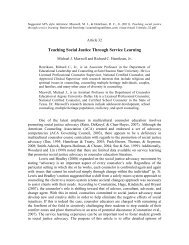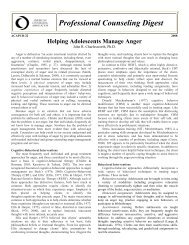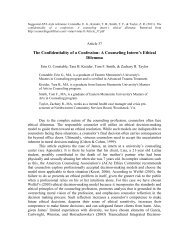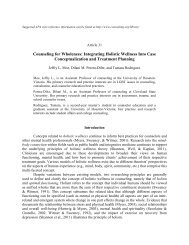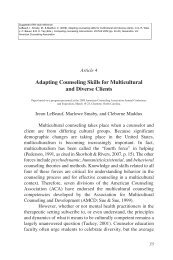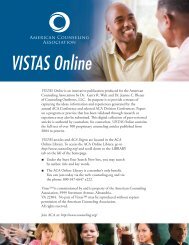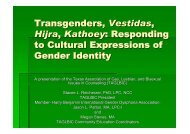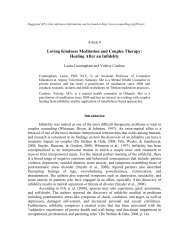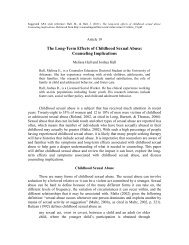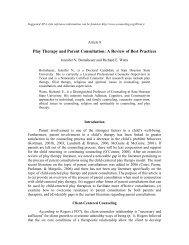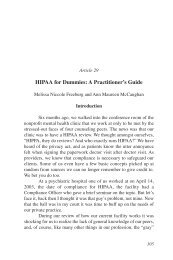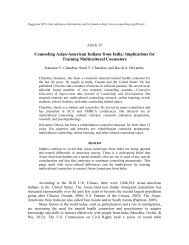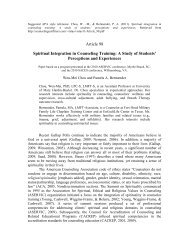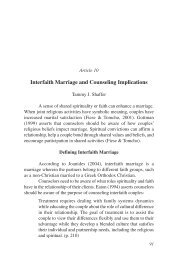Integrative Mental Health and Counseling - Counselingoutfitters.com
Integrative Mental Health and Counseling - Counselingoutfitters.com
Integrative Mental Health and Counseling - Counselingoutfitters.com
You also want an ePaper? Increase the reach of your titles
YUMPU automatically turns print PDFs into web optimized ePapers that Google loves.
Ideas <strong>and</strong> Research You Can Use: VISTAS 2011likely warrant additional documentation regarding informed consent about Reiki, bodilyboundaries, <strong>and</strong> clients‟ <strong>com</strong>fort level with the counselor <strong>com</strong>ing physically closer tothem than counselors usually work. This is such a fledgling area that the discipline ofcounseling <strong>and</strong> state licensing boards would eventually need to discuss the dualrelationships in this example <strong>and</strong> whether they are inappropriate or may be <strong>com</strong>patible.Critique of <strong>Integrative</strong> <strong>Mental</strong> <strong>Health</strong>There are two primary critiques of integrative mental health. The first critique is:do we really need to engage these approaches? Because this is a new phenomenon inmental health it will likely take time for counselors to accept CAM therapies as possiblyinfluencing their work. Regarding this point, it may be best to assess one‟s currentcaseload for clients who may be involved in an integrative therapy. As Tasaki et al.(2002) indicate with CAM <strong>and</strong> medicine, poor <strong>com</strong>munications between clients <strong>and</strong> theirCAM practitioners <strong>and</strong> between clients <strong>and</strong> counselors regarding CAM use may impedetreatment. The second critique is: given the apparent tentative conclusions of theresearch, how much do we know <strong>and</strong> thus, how much can counselors actually do toengage with CAM therapies intentionally to foster <strong>Integrative</strong> <strong>Mental</strong> <strong>Health</strong>? On thispoint, the best way to proceed might be to continue to be<strong>com</strong>e educated about CAM <strong>and</strong>its effectiveness as measured in the literature. As methods demonstrate better efficacy formental health treatment, then it would be suggested that counselors seek out continuingeducation about the pertinent therapies to learn how to either incorporate them into theirclinical practices directly or at least know what to expect from the therapies with respectto their effects on client presentation <strong>and</strong> treatment goals.It seems that as CAM therapies be<strong>com</strong>e more popular <strong>and</strong> widely used,counselors should be as prepared as possible to underst<strong>and</strong> what these therapies are <strong>and</strong>how they function in their clients‟ lives. This approach may evolve into a new counselingtheory called integrative mental health. As research methods evolve, <strong>and</strong> as more clientsseek out adjunctive or replacement therapies in CAM, the field of counseling can onlyexp<strong>and</strong> <strong>and</strong> grow as the field embraces its call to holism <strong>and</strong> optimal mind-body-spiritwellness. Gale <strong>and</strong> Austin (2003) cite Goldstein (1998) in that “counselors should acceptthe following mantra, „I not only will accept changes in knowledge <strong>and</strong> procedure in myfield, but I will wel<strong>com</strong>e such change <strong>and</strong> contribute to it‟” (p. 8). These changes appearto be arriving <strong>and</strong> while they bring methodological <strong>and</strong> practical challenges, they seem tobring gifts of wholeness for clients as well.ReferencesAstin, J. A., Harkness, E., & Ernst, E. (2000). The efficacy of “distant healing”: Asystematic review of r<strong>and</strong>omized trials. Annals of Internal Medicine, 132, 903-910.Barnes, L. L. (1998). The psychologizing of Chinese healing practices in the UnitedStates. Culture, Medicine <strong>and</strong> Psychiatry, 22, 413-443.Barnes, P. M., Bloom, B., & Nahin, R. L. (2008). Complementary <strong>and</strong> alternativemedicine use among adults <strong>and</strong> children: United States, 2007. National <strong>Health</strong>Statistics Reports, 12, 1-24.8



